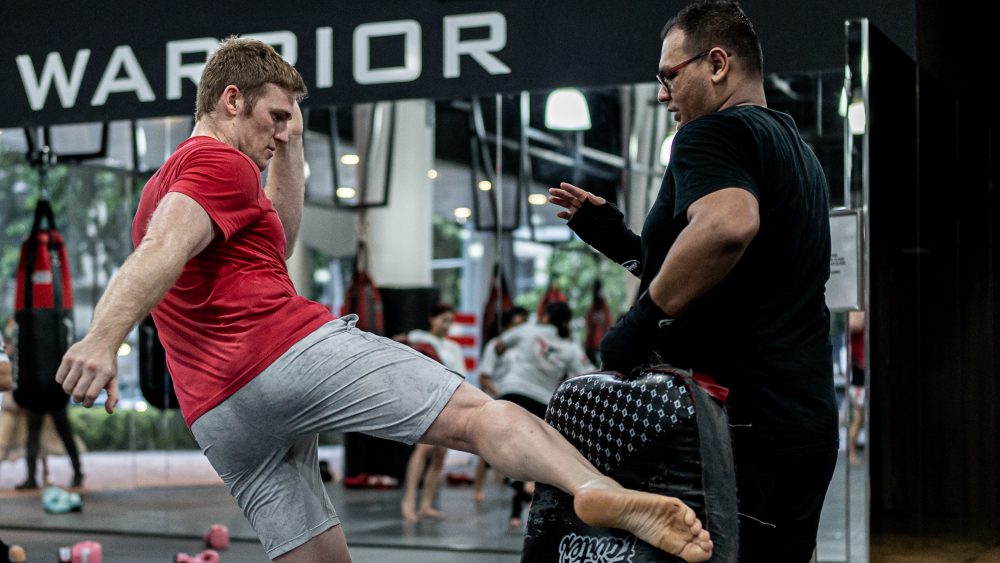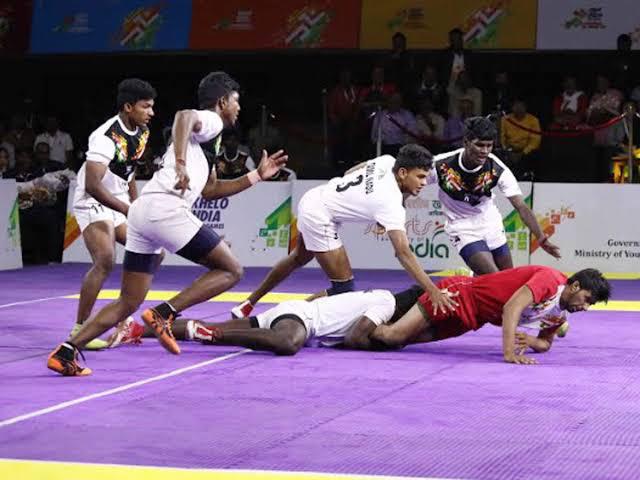High-intensity interval training (HIIT) alternates all-out efforts with brief rest or low-intensity periods. Unlike steady-state cardio, HIIT exercises, martial arts such as Muay Thai, and some aspects of BJJ, pushes you into anaerobic zones. Think 30 seconds of max-effort sprinting or burpees followed by 60 to 90 seconds of active recovery (walking, slow jogging, or easy shadowboxing).
Research shows that a typical HIIT session lasts 15–25 minutes, yet delivers metabolic and cardiovascular benefits comparable to, and often even exceeding, traditional 45- to 60-minute workouts.
Why HIIT Works
- VO₂ Max Gains: Meta-analyses report that HIIT can improve your VO₂ max (the gold-standard measure of aerobic fitness) more than moderate-intensity continuous training, sometimes by as much as 10–15% over eight weeks.
- Afterburn Effect (EPOC): Post-exercise oxygen consumption remains elevated for hours after HIIT workouts, meaning you burn extra calories long after you leave the gym.
- Time Efficiency: It’s easier to make room for a 20-minute HIIT session when your schedule is full with work and family obligations.
Safety And Programming Tips
- Build A Base: If you’re new to HIIT, start with 10–15 seconds of high effort and 45 seconds of recovery, then scale up.
- Warm Up And Cool Down: Never skip five minutes of mobility drills, joint prep, and light cardio for warm-ups. Your body needs to prepare itself for the intensity of HIIT circuits. Likewise, finish your workouts with static stretches to aid recovery.
- Monitor Intensity: You should be going at close to full intensity when performing your reps.
- Limit Frequency: Limit HIIT workouts to no more than three times per week to allow your central nervous system and muscles to recover.
HIIT Modalities For MMA Athletes
Some exercises that translate into movements used in mixed martial arts include:
- Sprints & Hill Runs: Aim for ten sets of 20-second all-out road sprints with 60 seconds walk back to the starting line. This mimics the go-and-pause nature of a fight, where you throw a few combinations and reset.
- Bike Or Rower Intervals: Go for eight sets of going all out for 30 seconds on the max setting of an exercise bike or an appropriate weight on a rower. Rest for 90 seconds between sets
- Bodyweight Circuits: Alternate every minute on the minute between burpees and jump squats. Perform ten burpees as fast as you can and rest for whatever is left during the minute. Do 15 jump squats as fast as you can, then rest for the remainder of the minute. Keep going for 12 minutes.
- Weighted Sled Pushes: Run 20 meters while pushing a sled with about 80% of your bodyweight. Rest for 90 seconds and repeat the exercise six to eight times.
- Battle Ropes Plus Bag Drills: Spend 30 seconds on battle ropes and the next 30 working boxing combinations on a heavy bag. Rest for 60 seconds. Aim for three to five rounds.
What Are Skill-Drill Workouts?

Skill drills break techniques down to their core, helping you sharpen each movement with focus and precision.
Skill drills isolate the technical building blocks of martial art techniques, helping you to refine them. Unlike free sparring sessions where you have to deal with countless variables, skills drills let you hammer specifics: the hip snap of a Muay Thai teep, the hip rotation when throwing strikes, the proper setup for a submission.
Skills drill allows you to master technique via repetition as you build muscle memory. Over time, your nervous system learns how to perform techniques automatically without having to think about the different steps involved, which is vital for the later rounds of fights when fatigue kicks in.
Benefits Of Skill-Drills
- Neural Adaptation: Repeated patterning accelerates signal transmission between your brain and muscles, shaving milliseconds off your reaction time.
- Error Correction: Isolated reps let you slow down and fix mechanical flaws before they become habits.
- Adaptive Timing: Mixing drill tempos (slow, normal, lightning-fast) fine-tunes timing against different opponent speeds.
More Drills To Level Up Your Game
Let’s take a look at a few more drills and their benefits for specific martial arts:
1) Muay Thai
- Teep Ladder: Alternate between front-leg and rear-leg teeps at increasing heights. Perform five reps aiming low, mid-level, and high with each leg and rest for 30 seconds before starting your next round. Aim for four rounds.
- Switch-Step Combinations: Switch stances and throw a jab–cross–roundhouse combination. Switch stances and repeat with your other leg. Repeat ten times on each side to complete a round. Aim for four to five rounds with 30-second breaks in between.
- Pad Rounds: Spend 60 seconds working offensive combinations, 30 seconds performing defensive movements, and rest for 60 seconds.
2) Brazilian Jiu-Jitsu
- Positional Frames: Perform shrimping and bridging drills for 60 seconds and rest for 30 seconds. Aim for four to five sets.
- Partner Flow-Rolling: From closed guard, practice five transition sequences with light resistance, then trade spaces. Keep going for four to five rounds.
- Grip-Release Drill: Start standing facing a training partner and grab their lapel. One partner pulls, while the other breaks grips. Give going for 60 seconds before switching roles.
3) Wrestling
- Sprawl & Change-Level: Perform ten quick sprawls. Immediately drop levels and shoot in as you come up after each sprawl. Rest for 60 seconds and repeat 5 times.
- Ankle-Pick Drill: Begin from your wrestling stance and perform ten ankle-pick takedown entries, focusing on shooting your lead arm toward your partner’s ankle. Switch stances and repeat on your other side. Rest for 30 seconds before starting your next round.
4) Boxing Drills
Heavy Bag Drill: Throw power hooks for 20 seconds, rest 10, then rapid straight punches for 20 seconds, rest 10, followed by mixed combos (2 punches, 1 kick, 2 punches) for 20 seconds. Rest 30 seconds. Complete 3 rounds.
Shadowboxing T-Drill: Mark a “T” shape on the mat. From the center, step forward with straight punches, left with jab-cross, back with hooks, and right with jab-lead hook. Repeat the pattern for 3 minutes, focusing on footwork and technique. Rest 30 seconds, 3 rounds total.
Put It All Together And Dominate
Blending HIIT with targeted skill drills gives you the engine and the toolbox to dominate in MMA. You’ll strengthen your cardiovascular system, torch fat, and refine your techniques when you combine both.
You may also like:
How To Make Your First Sparring Session Less Intimidating
Feeling a little anxious heading into your first sparring session in martial arts is perfectly normal. You’ve never had the chance to test your skills against resisting opponents, and you’re unsure about how well you’ll…
The cross is one of the most powerful punches in a boxer’s arsenal, and it also covers more distance than every other type of punch besides the jab. It’s an outside range weapon that can…
In striking arts, size and reach are important tools, but they don’t guarantee success. When facing a smaller opponent, the challenge often lies in their speed, mobility, and ability to slip into range before you…
Kazakhstan is home to famous boxing and fighting icons like Gennadiy “GGG” Golovkin and Shavkat Rakhmonov. The country is known for its rich culture and heritage, producing some of the toughest and fiercest warriors on…
Head shots lead to some of the most amazing finishes in combat sports such as Boxing, Muay Thai, or Mixed Martial Arts, but body shots accomplish the same goal in a subtler way. A well-executed…
Boxing is a sport where fighters develop not only physical skills but also distinct personalities and philosophies in the ring. Over time, certain approaches to fighting have become so recognizable that they’re referred to as…
Bullying often brings out all sorts of negative emotions in children, and parents usually don’t know how to start the conversation. Children tend to be hesitant to admit they’re getting bullied because it often makes…
In BJJ, Submission Grappling, and Wrestling, improving your ability to explode into takedowns doesn’t just add more brute strength to your takedowns, it also allows you to close distances quicker as your entry speed increases….
Many professional athletes incorporate swim training into their workout routines to take their training to the next level. Swim training pushes your lung capacity and muscle endurance, helping to build you into a more durable,…
You’ve probably heard that martial arts training builds character, discipline, and confidence, but did you know it can also help children with attention-deficit/hyperactivity disorder (ADHD) manage their symptoms? In a fast-paced, academically driven place like…
Nowadays, it’s common for teenagers to spend hours each day on electronic devices like smartphones, tablets, TVs, and gaming consoles. Most of them spend way more time staring at screens than they do on their…
Intermittent fasting (IF) has been popular among martial arts fighters for decades, with legends like Georges St. Pierre swearing by its effectiveness. While the idea of skipping meals before intense training often sparks debate, this…
































